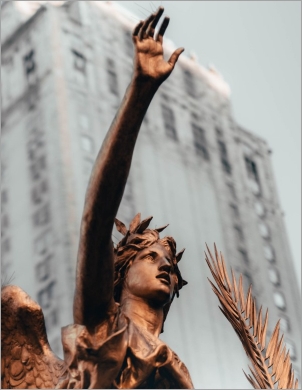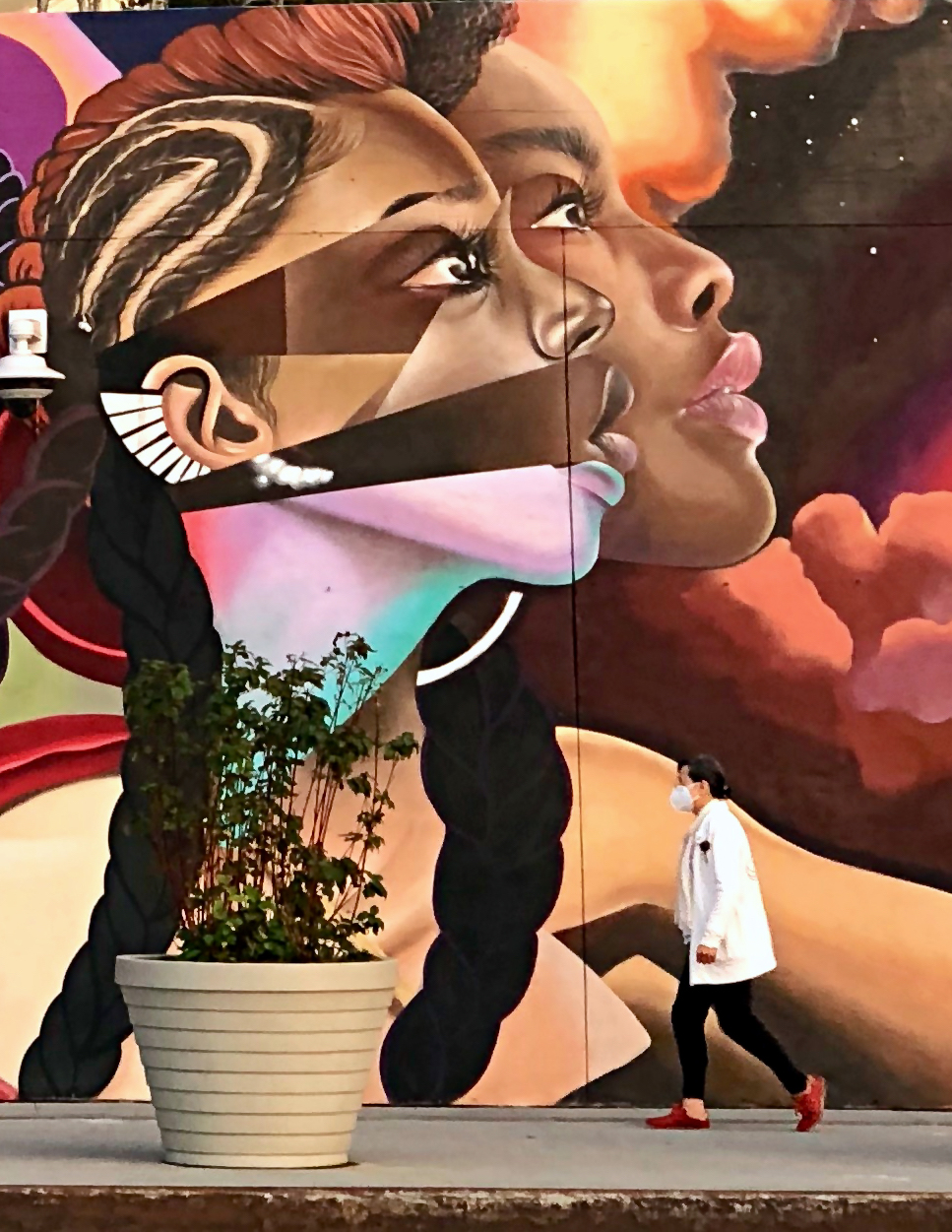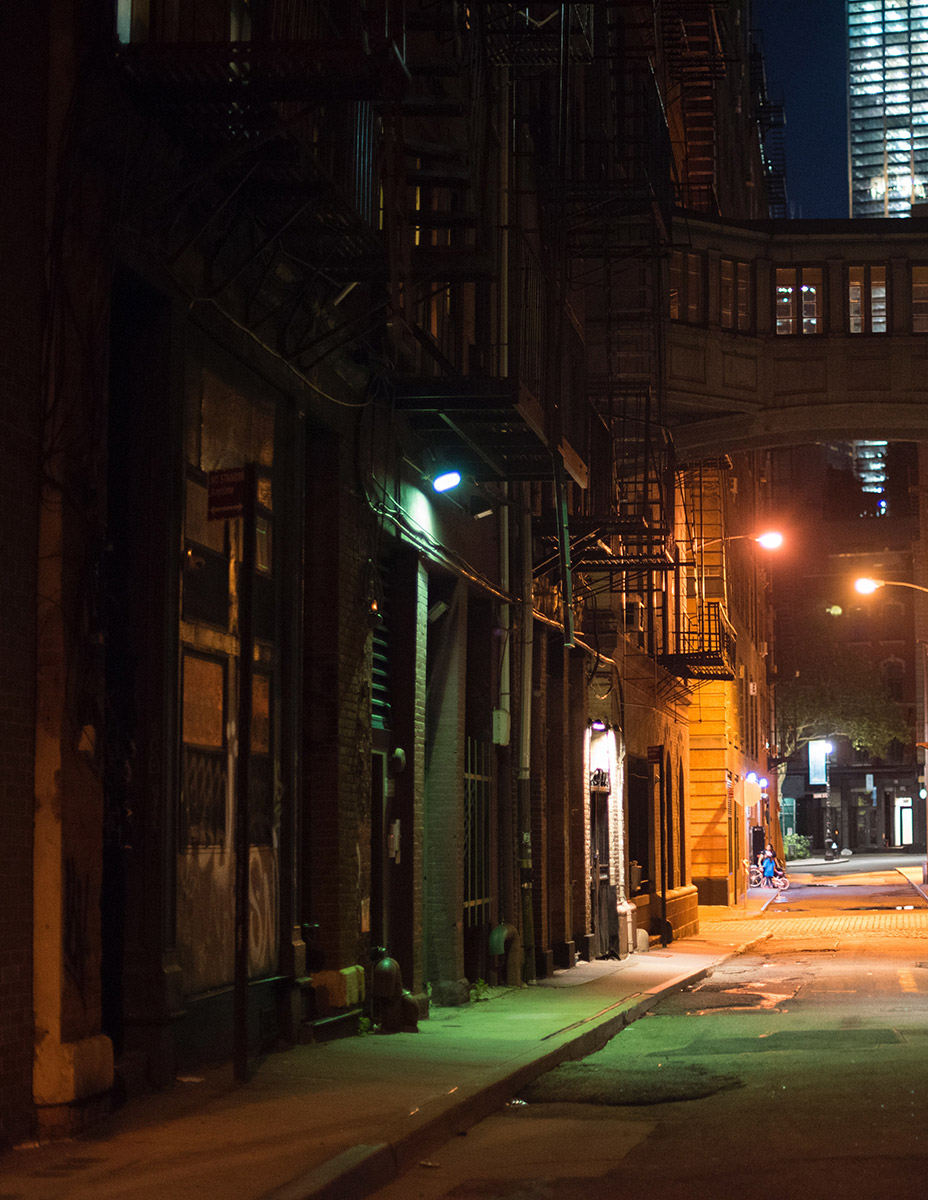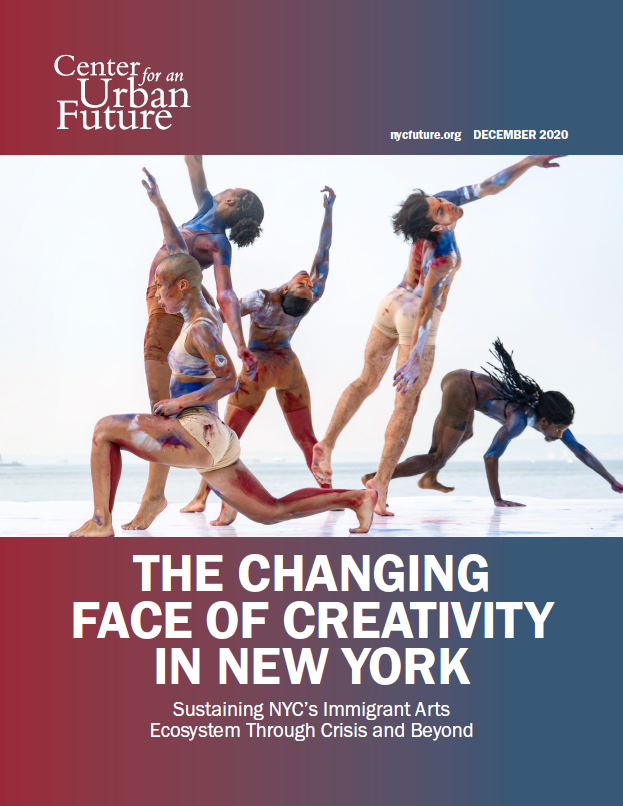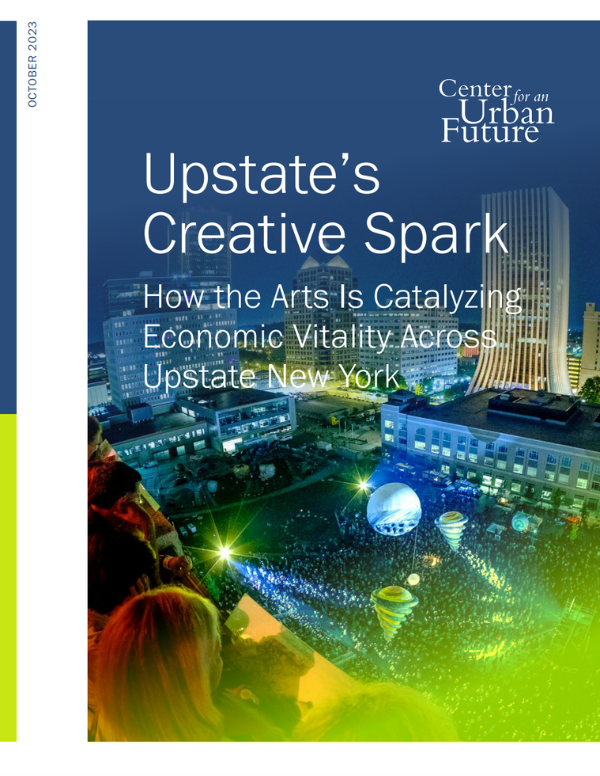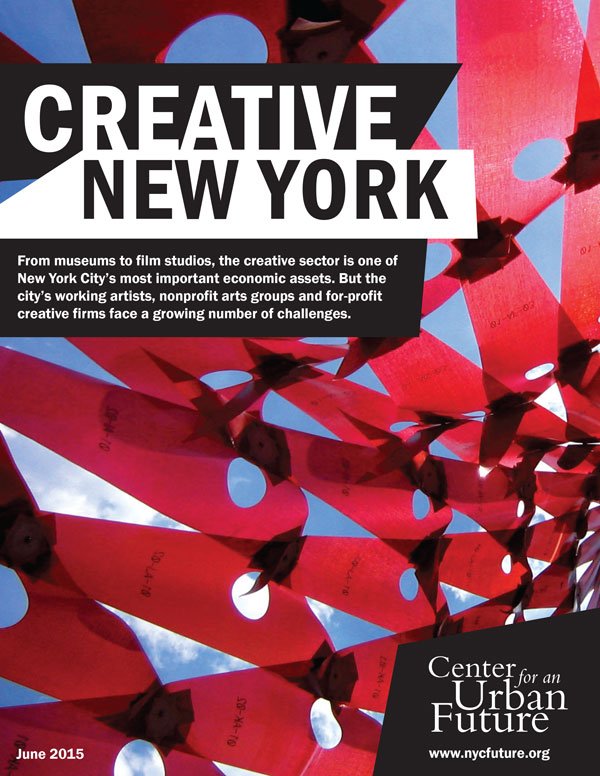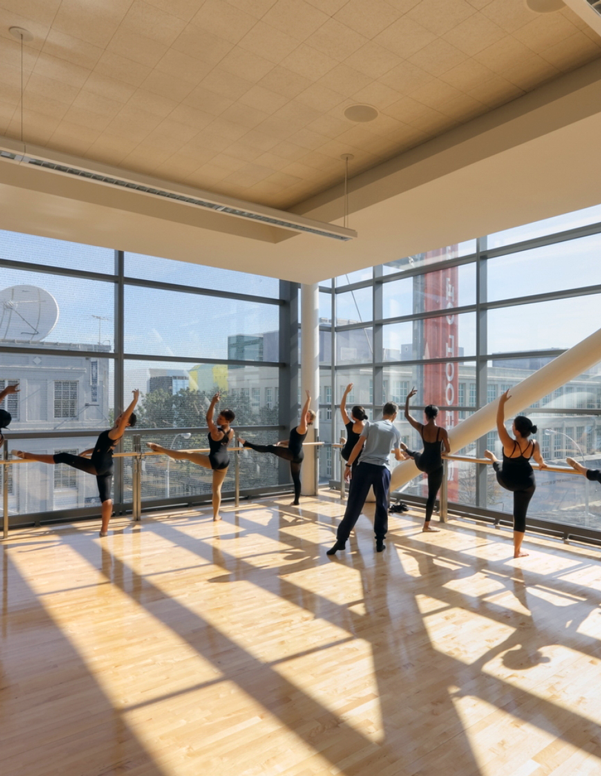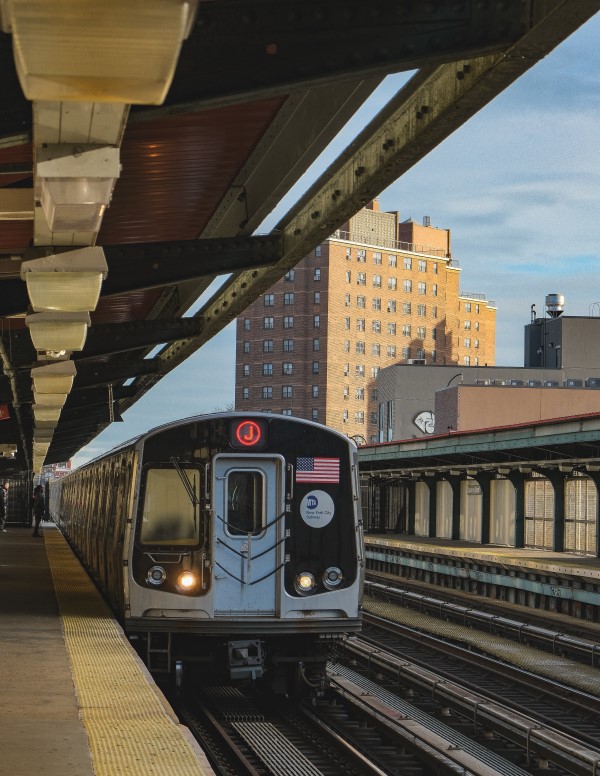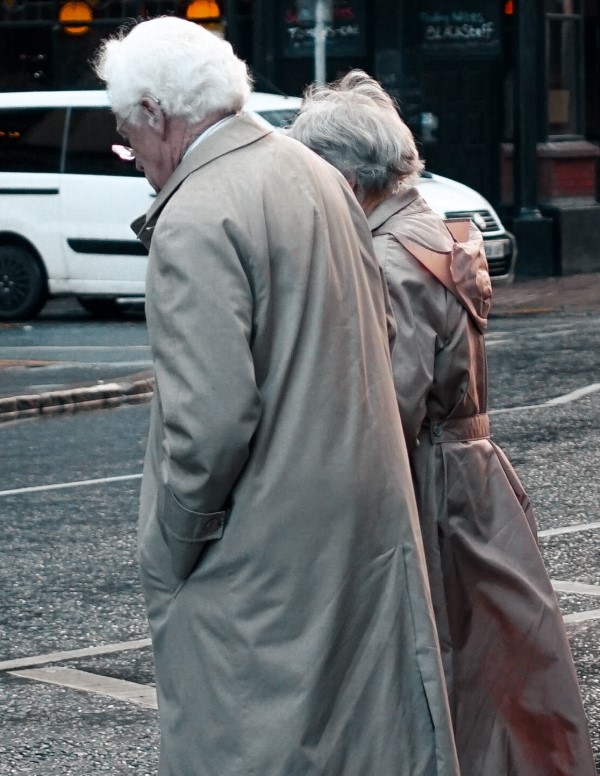New York City’s vibrant arts and cultural sector has endured extraordinary challenges over the past several weeks. In an effort to contain the spread of the novel coronavirus, the city’s thousands of independent theatres, nightclubs, galleries, and performance venues have gone dark, and countless arts organizations have been forced to cancel nearly every event, opening, workshop, and public program on their calendars. For these organizations—and the many working artists employed by them—the economic impact of this mandatory shutdown is unlike any in recent memory.
The city is just beginning to grapple with the scale of the crisis in the arts. While some major institutions including the Met Museum, MoMA, the Whitney Museum, Carnegie Hall, and the New Museum have projected stunning financial losses—accompanied in some cases by furloughs and layoffs—much less is known about the full consequences of the pandemic on the city’s small and mid-sized arts organizations and on working artists themselves.
To better understand the existential threat faced by the city’s smaller theatres, concert halls, museums, nightlife venues, and community cultural hubs, as well as artists themselves, we reached out to over two dozen arts organizations and individuals. In candid and often emotional interviews, community arts leaders described growing fears for their organizations’ survival. We heard from the leaders of arts groups and institutions across all five boroughs including the Tenement Museum, Brooklyn Conservatory of Music, Nuyorican Poets Cafe, Flushing Town Hall, BAAD! Bronx Academy of Art and Dance, and the Staten Island Children’s Museum; from independent music promoters like AdHoc Presents and theater companies including Black Spectrum and Keen Company; and directly from dancers, playwrights, and visual and performing artists whose lives and careers have been upended.
Our research found that nearly all small and mid-sized arts organizations are facing slashed budgets and reduced staffing, and many are teetering on the brink of insolvency. With their doors shuttered and all in-person events either cancelled or postponed, organizations and venues are losing months of revenue needed just to stay afloat. Many have been forced to lay off staff and consider indefinite closure. Organizations that rely heavily on grants and donations do not know whether they’ll receive previously committed funding, and have lost the financial foundation provided by springtime fundraisers and galas. Although larger cultural institutions are also facing stunning losses, many smaller cultural groups don't have the benefit of endowments or large donor bases to help cushion the blow as they experience staggering declines in earned revenue from cancelling performances, closing museums, calling off tours, and shutting down art classes. Even the end of social distancing may not bring immediate relief. Many arts groups fear that the arts will be among the worst-hit sectors in the coming months of economic recession as the public pulls back on spending. And while some artists can continue their work from home and on virtual platforms, many others—particularly performing and ensemble artists who make their income from shows and tours—expect to be unemployed for the foreseeable future.
Among our key findings:
New York City’s small and mid-sized arts organizations project steep revenue losses—from 17 percent to 50 percent or more of their annual operating budgets.
- The Staten Island Children’s Museum projects $630,000 in lost income—nearly 30 percent of the museum's $2.2 million annual operating budget.
- Brooklyn-based Beth Morrison Projects has had to cancel eight tour engagements and two workshops. This has resulted in a projected loss of about $800,000 in gross income from performance and tour fees—over a quarter of its $3 million operating budget.
- Flushing Town Hall projects losses of $400,000 in earned income through June—over 17 percent of its annual budget.
- The CANVAS Institute on Staten Island has had to cancel four exhibitions and all rentals and has already lost $25,000 to $30,000—almost a third of its annual operating budget, which averages just over $100,000.
- The Nuyorican Poets Café expects a loss of $302,000 if closed through July—almost half of its annual revenue.
- Brooklyn-based theater company Parallel Exit is on pace to lose a third of its revenue if its doors are shut until just mid-April—$25,000 in revenue on a $75,000 budget.
- Jamaica Center for Arts and Learning faces a revenue shortfall of $225,000 due to lost revenue from rental, registration, tuition, box office, program services, and corporate support.
- BAAD! Bronx Academy of Art and Dance has been forced to cancel 18 shows planned over the next three months, which were expected to bring in about $9,000. “We’ve weathered a lot of storms,” says co-founder Charles Rice-González, “and this one feels like a tsunami.”
With little cash on hand and few if any reserves, many small and mid-sized arts organizations have had to lay off or furlough staff.
- Prior to the pandemic, the Tenement Museum employed 67 full-time staff and 75 part-time workers. But now all part-time workers have been let go, and the full-time staff is down to 51 people, of which only 15 remain on payroll (and most of those are working just every other week).
- With a $2.3 million budget, Flushing Town Hall has only about $40,000 cash on hand—less than 2 percent—and no endowment. It lacks the cash to continue paying teaching artists and will not be able to make payroll if its city contracts are canceled or scaled back.
- All of the 60 employees at Nowadays, an indoor/outdoor nightlife venue on the Ridgewood/Bushwick border—including contractors and part-time workers such as security guards and sound technicians—are no longer being paid.
- Black Spectrum Theater Company had to stop paying staff after March.
- AdHoc Presents, a leading promoter of independent live music, has had to trim its staff from seven to four now that all concerts are canceled.
- Beth Morrison Projects was forced to eliminate two positions from a staff of nine.
Many organizations are heavily reliant on earned revenue, but social distancing threatens to all but eliminate that crucial source of income.
- Roughly 70 percent of the Brooklyn Conservatory of Music’s FY 2020 budget—$3.3 million out of $4.7 million—comes from earned revenue, a huge risk right now given the social distancing policies put in place.
- 75 percent of the Tenement Museum’s $11.5 million annual operating budget is generated from earned income, which puts the organization at grave risk.
- More than 40 percent of the $220,000 the budget for the nonprofit Bangladesh Institute of Performing Arts (BIPA) comes from revenue raised from its classes teaching Bangla music and dance. “I don’t think people are going to go back to their normal life as they were before coronavirus—because the fear is going to be there,” says cofounder Annie Ferdous. “I don’t know how long it will take to get back to the same situation again.”
- At the Centro Cultural Barco de Papel in Jackson Heights, a Spanish-language bookstore and arts venue, the crisis is hitting its patrons particularly hard, which threatens the nonprofit’s viability. “We are surviving based on the immigrant population, which is the ones that are being hit the most,” says Paula Ortiz, executive director of Barco de Papel. “They need to prioritize their needs. And a book is not an essential need. A cultural event is not an essential need.”
Working artists have lost up to one-third of their annual income and face months of canceled projects and likely unemployment.
- Hussein Smko spent two years creating an autobiographical dance work titled Project-TAG, but the premiere has now been canceled. A future tour of Kurdistan has also been canceled and he lost a potential $40,000 grant and had to cancel a fundraiser, both due to the pandemic.
- Experimental composer, performer, and sound designer Lea Bertucci was scheduled to tour across Europe and Australia this spring. Instead, after only four of her 22 performances in Europe, she was forced to buy a plane ticket home to Queens. “Now the bulk of my income has been completely decimated,” she says. She’s lost 25 performances amounting to $15,000— a roughly 33 percent loss to her annual income.
Despite these alarming findings, our interviews also found reasons for hope. Many artists are participating in mutual aid networks, making ends meet collectively while waiting on emergency government assistance. Organizations and venues have worked rapidly to move educational and public programs online, while continuing to support their artists, workers, and patrons. Some are counting on the New York Community Trust’s $75 million Covid-19 Response & Impact Fund, emergency grants from the NYC Department of Small Business Services, future initiatives from the Department of Cultural Affairs, or the potential of an expanded federal relief package. Yet it’s clear that New York City’s vibrant community-centered cultural life cannot endure a prolonged shutdown without major new sources of support.
The following profiles capture the state of emergency facing organizations and artists citywide and suggest the need for urgent action to stabilize organizational budgets, provide direct relief to artists and workers, and ensure that the city’s unique landscape of small and mid-sized arts organizations can survive this crisis.
Community Arts & Education
Flushing Town Hall
Flushing Town Hall has cancelled roughly 40 programs as well as residencies with the Department of Education. The organization projects losses of $400,000 in earned income through June, including potential proceeds lost from a cancelled June fundraiser. And with events space rentals covering 20 percent of the operating budget, a decrease in summertime rentals could result in major, additional losses—especially because the organization must continue to invest in maintenance of its landmarked building.
With a $2.3 million budget, the organization has only about $40,000 cash on hand—less than 2 percent—and no endowment. It’s also largely dependent on government contracts and grants, so any cuts to public funding would be a big blow. It remains unclear whether certain city contracts will be honored, and the organization won’t be able to make its next payroll if those contracts are canceled or scaled back. While Flushing Town Hall paid its teaching artists for two weeks of cancelled work, it lacks the cash to continue paying them, though the organization hopes to continue employing some through online platforms.
The organization offers programs in music, theater, dance and spoken word, along with family and education programs, senior programs, exhibitions, and free community events, and employs a diverse roster of teaching artists.
Brooklyn Conservatory of Music
Roughly 70 percent of the Conservatory’s FY 2020 budget—$3.3 million out of $4.7 million—comes from earned revenue, a huge risk right now given the social distancing policies put in place. Indeed, two thirds of its budget comes from on-site music lessons and music therapy offered at its Park Slope home, and one third from off-site music education programs that it presents around the city at public schools, senior centers, and other community sites. Staff are uncertain which of this year’s off-site contracts will be honored, and how the economic crisis will impact on-site class enrollment for the coming fiscal year.
The conservatory is also worried about decreased charitable contributions. Contributed revenue makes up roughly $1.25 million of the budget, but the conservatory was forced to cancel its annual spring fundraiser, losing a major source of donations in the process. Staff are also concerned about future individual donor and foundation giving.
Revenue from concerts and rentals make up approximately 5 percent of the annual budget, and this has evaporated, too. “For an organization that’s also trying to do what it can for its staff and faculty, with a very thin capital reserve, losing some portion of that income is enough to throw us into losses for the year and to start to erode our capital reserves—and many organizations have virtually no capital reserves,” says executive director Chad Cooper.
Since the outbreak of the pandemic, the organization has worked vigorously to launch remote learning programs and is already reaching 900 people. Yet this transition has come at a great cost. “It’s not just about the loss of revenue and the huge loss of productivity—it’s also about the additional unbudgeted investment that organizations need to make in order to kind of retrofit ourselves to become effective providers of remote learning,” says Cooper. “There are costs to paying for Chromebooks and Zoom licenses and all the time for skill building, developing new pedagogy.”
CANVAS Institute for Arts, Culture and Civic Engagement
The CANVAS Institute, a multidisciplinary arts and culture space on Staten Island’s North Shore, had been planning four major exhibits for 2020, some featuring international and out-of-state artists. “All of that work has gone down the tube,” says Bobby Digi, who launched CANVAS in 2016. As a result of exhibition cancellations, in addition to lost rental income, CANVAS has already lost $25,000 to $30,000—almost a third of its annual operating budget, which averages just over $100,000.
With a partner, Digi also opened a restaurant—O’Henry’s Publick House—in December, and was planning on hiring musicians to perform there. One of his restaurant workers is now facing homelessness, while a musician Digi planned to employ is now out of their main source of income. Digi is concerned that the inequities faced by Black- and minority-owned art spaces like CANVAS will only be exacerbated during the coming months. “The bigger organizations are going to figure out [how to access emergency funding] much faster,” he says. “They’re going to get the bulk of the money and most of the sympathy.”
Jamaica Center for Arts and Learning
Jamaica Center for Arts and Learning (JCAL), a multidisciplinary arts center based in Jamaica, planned for an FY 2020 operating budget of $2.075 million, but now faces a revenue shortfall of $225,000 due to lost revenue from rental, registration, tuition, box office, program services, and corporation supports.
“We are trying to survive this fiscal year and to keep as many staff as possible, but we fear that we might need to cut down hours or lay off staff if the situation continues,” says Cathy Hung, executive director of JCAL. “The biggest impact is on paying our teaching artists since there will be no classes, and no contract services now to schools and senior centers.”
Chinatown Soup
Chinatown Soup, a Lower East Side–based, nonprofit art gallery, creative community, and cafe dedicated to “art, justice, historic preservation, and civic engagement,” has lost all its revenue from space rental, artist residency fees, programming tickets, and in-store café/shop sales—a projected total of $12,000 for March and April. This loss could total $20,000 if programming can’t pick up again in May.
While Soup’s landlord has offered a 30 percent discount on rent for April, May, and June—an offer Soup appreciates—the discount will not resolve the deficit. “Soup’s saving account has enough to cover six weeks of rent,” says Michelle Marie Esteva, Chinatown Soup’s founder and director. Utilities bills will further eat into that small runway. In the meantime, Soup’s artists are partnering to apply for grants to support the residency program and have pledged artworks for an upcoming fundraiser, while others have been donating to support Soup’s continuation.
“Best case scenario: Soup is able to raise more funds than expected due to the public's heightened awareness of how this crisis has threatened small businesses and art spaces. Worst case scenario: We raise nothing from our efforts and are left to negotiate a handout with Soup's landlord.”
Centro Cultural Barco de Papel
Opened as a small Spanish-language bookstore in Jackson Heights, Barco de Papel has grown into a nonprofit cultural center that hosts open mics, readings, concerts, and other events that frequently sprawl out of the storefront onto the sidewalk outside. El Centro Cultural Barco de Papel has faced its own set of challenges even before the pandemic: managed by an all-volunteer team, the organization has had to adjust when volunteers move away or can no longer commit time to the project.
Those challenges have been severely exacerbated by the economic crisis facing Queens residents. “We are surviving based on the immigrant population, which is the ones that are being hit the most,” says Paula Ortiz, executive director of Barco de Papel. “Whether you have papers or not, that work class is going to be impacted. They need to prioritize their needs. And a book is not an essential need. A cultural event is not an essential need.”
The fate of the bookstore space itself is unclear, and the center is unsure to what extent it will be able to sustain volunteer labor or community donations. For instance, it was planning a $7,000 street mural project for this year, of which $5,000 was to come from fundraising and $2,000 from a foundation grant, but now both sources of funding are endangered.
Bangladesh Institute of Performing Arts
More than 40 percent of the $220,000 the budget for the nonprofit Bangladesh Institute of Performing Arts (BIPA) comes from revenue raised from its classes teaching Bangla music and dance forms like Bharatanatyam, Kathak and Manipuri to students across Queens and Brooklyn. But that key income source will now be significantly lower due to the school's closure. BIPA also raises much of its funds from public grants, but that also could be affected. The organization also lost $7,600 in funds spent on supplies and costumes for its cancelled March Children’s Festival and on costumes for its April Bengali New Year festival.
Another pressing concern is future enrollment. “I don’t think people are going to go back to their normal life as they were before coronavirus—because the fear is going to be there,” says cofounder Annie Ferdous. “I think we are going to lose students, and I don’t know how long it will take to get back to the same situation again. If we can’t get grants in the future, it will be hard for the organization to run. Maybe we will have to go back to our basement studios—no more big spaces like our school cafeterias.”
Laundromat Project
The coronavirus crisis has disrupted more than just funding for the Laundromat Project, which cultivates arts engagement in local laundromats and other public spaces. “We’re activating workshops on a street corner, in a community garden, or in a public plaza, but now we’re not allowed to convene with one another in those spaces,” says Ayesha Williams, the Laundromat Project’s deputy director.
Before the coronavirus hit, the Laundromat Project was about to launch a 15th anniversary Spring Appeal, which was delayed and has just launched this week. Now the organization worries whether they can generate the necessary funds to convene their artists and publish work documenting their unique approach to teaching and learning about art and social change.
The team is transitioning its programming online and challenging their artists to reimagine their workshop formats. The community has also discussed developing a registry to help artists market their creative skills to employers in other fields, as well as finding ways as artists to support service, restaurant, and healthcare workers. Yet the organization faces uncertainty due to its dependence on public and private contributions.
Small and Mid-Sized Museums
Staten Island Children’s Museum
The Staten Island Children’s Museum ability to maintain operations is now very much at risk. With the museum closed for the foreseeable future, Executive Director Dina Rosenthal projects a loss of $630,000 in income—nearly 30 percent of the museum's $2.2 million annual operating budget. Keeping all staff on payroll will require the museum to run a deficit and dip into reserves, as it has just $120,000 in cash on hand. While the museum has committed to paying all non-seasonal employees through April 15, next steps are still unclear. (The museum employs 50 people—including 12 full-time staff, 28 part-time staff, and 10 paid interns—along with seasonal staff.)
The pandemic has also threatened the future outlook of this welcoming, interactive space. “We are very concerned about what the future of hands-on, interactive children’s museums looks like,” says Rosenthal. “We have to understand how a hands-on museum can best be a resource in this new pandemic and post-pandemic reality."
Tenement Museum
Because about 75 percent of their $11.5 million annual operating budget is generated from earned income, the Tenement Museum is facing a dire situation. With a cash balance of about $1.2 million at the end of February, the museum has had to make large cuts to reduce their roughly $1 million in monthly expenses down to $300,000, including cutting payroll from $665,000 in March down to $100,000 by May. Prior to the pandemic, it employed 67 full-time staff and 75 part-time workers. But now all part-time workers have been let go, and the full-time staff is now down to 51 people, of which only 15 remain on payroll (and most of those are working just every other week). The museum is also continuing to cover health insurance for all full-time staff, whether or not they’re on payroll.
“All of a sudden, a source of strength becomes an extreme vulnerability, and we needed very clearly to adjust. It’s one thing if you have a major endowment—and we have none,” says president Morris Vogel, referring to its level of earned revenue.
The Tenement Museum’s buildings also include about a dozen apartments, and even if renters are unable to pay rent, the museum must continue to pay for maintenance. And like many other cultural institutions, the museum had to cancel its April gala, which would have netted about $700,000. They are now trying to raise money online, but Vogel is concerned there may be less giving this year. If emergency appeals are successful, the museum might be able to close out the fiscal year with $700,000 left in the bank. But even in a best-case scenario—a quick reopening—they expect revenue to drop due to decreased tourism. And the worst case?
“This epidemic doesn’t clear in June, July, August. It’s still here, with no confidence about where it’s going by the end of summer, and we’re closed,” says Vogel. “Worst, worst, worst case? We owe $50,000 a month to the bank. We have essentially a mortgage, it’s a bond . . . we own three buildings. Bank can take them. We have to give them the keys. We’re a memory.”
Theater & Performing Arts
According to an ongoing survey by the Alliance for Resident Theaters, member theaters reported a 56 percent loss of earned income and 31 percent loss of contributed income—a total of $47 million. By end of June, A.R.T. has estimated that losses would triple to $140 million.
BAAD! Bronx Academy of Art and Dance
BAAD! Bronx Academy of Art and Dance has been forced to cancel 18 shows planned over the next three months, which were expected to bring in about $9,000. The organization, which champions performance by LGBTQ artists of color, is working hard to transition programming online where possible, and to pay artists for their work on online platforms, but these efforts have led to new costs. BAAD! is expending an additional $3,500 to pay artist fees for new online programs that can’t be covered by other current grants. BAAD! also paid out $2,500 to technicians, house managers, and maintenance workers for four cancelled shows, and will continue to pay $20,000 in rent and utilities over three months even though the organization cannot use its building.
“When you start out not adequately resourced to do the things that you do, and that position of not being adequately resourced becomes worse, it becomes even more challenging,” says Rice-González. “We’ve weathered a lot of storms, and this one feels like a tsunami.”
Beth Morrison Projects
Brooklyn-based Beth Morrison Projects (BMP), which commissions, develops, produces, and tours new works by contemporary composers working in opera-theatre, music-theatre, and vocal-theatre, has had to cancel eight tour engagements and two workshops. This has resulted in a projected loss of about $800,000 in gross income from performance and tour fees—over a quarter of its $3 million operating budget. About $200,000 of the $800,000 would go towards BMP’s operating costs—the rest is artist/production fees and related expenses. Along with an anticipated loss of roughly $50,000 in contributed income between now and the end of the fiscal year, BMP’s operating losses total at least $250,000.
With 60 to 70 percent of the company’s budget dependent on earned income, BMP is highly vulnerable to the crisis’s impact. The company also continues to pay out $60,000 in overhead costs, including rent, salaries, and storage, and were recently forced to eliminate two positions from a staff of nine. At the same time, the company is also seeking ways to compensate artists for cancelled performances.
“We have never incurred a deficit in our 14-year history,” says founder Beth Morrison, “not even during the economic downturn. Over the years, we have built a modest cash reserve that, at this time, we expect can keep BMP operating through August. After that, it’s less certain.”
Keen Company
The twenty-year-old Keen Company is a company-in-residence at Theatre Row, an off-Broadway theater complex in the Garment District. The company puts on intimate productions of plays and musicals, fosters new acting and writing talent through its teens program, and brings together mid-career playwrights to develop new work. When Governor Cuomo ordered the closure of large venues like Theatre Row on March 12, Keen was nearing the end of its run of Pearl Cleage’s Blues for an Alabama Sky. The company had to cancel the remaining four performances, losing about $10,000 in revenue—but that is only the start of its troubles.
Keen has postponed its annual gala, which was expected to bring in enough donations to cover a quarter of its $730,000 operating budget. The company has also had to delay paying bills, which impacts artists and contractors, and has canceled the remainder of this season’s Keen Teens program. The board is stepping up, but the company fears that fundraising efforts may fall short. “If we are not able to go ahead with the rescheduled gala in June, I am concerned that our company may not survive,” says Jonathan Silverstein, Keen Company’s artistic director.
Black Spectrum Theatre Company
Earned income from facility rentals, performance ticket sales and membership usually make up one-third of all revenues for Black Spectrum Theatre Company, a multifaceted performing arts and media company with a theater and film studio located in Jamaica. Today, all of that earned income has disappeared. Additionally, its credit line at the bank is exhausted, and, according to founder Carl Clay, city grants that the company has been awarded in recent months have yet to be disbursed. Making matters much worse, Clay says that the organization is going to have to cancel its 50th anniversary gala, which had been planned for April. Clay says he had to stop paying staff after March.
Parallel Exit
Brooklyn-based theater company Parallel Exit is on pace to lose a third of its revenue if its doors are shut until just mid-April, according to artist director Mark Lonergan. Responding to an A.R.T survey, Lonergan says Parallel Exit stands to lose $25,000 in revenue on a $75,000 budget. The theater faces $16,000 in financial liability, which Lonergan is currently covering out of his own pocket.
“Any possibility of refunding Parallel Exit for the time we lost is now becoming a vital lifeline for my company, and for myself personally,” he says.
Parallel Exit supports the production and performance of new works across the city and the world, and also offers free in-school and community performances and workshops for public school children and families.
The Brick
The Brick, an experimental, 70-seat theater in a renovated garage in Williamsburg, is set to incur a roughly $40,000 loss if it must remain closed until June. “This is a potentially devastating blow," says Theresa Buchheister, The Brick's artistic director. "Worst case, we declare bankruptcy."
All five employees are considering whether they can afford to wait, and Buchheister hopes for assistance from the city to cover 40 percent of payroll. While the theater is unable to pay companies whose shows had to be cancelled, they are hoping for the opportunity to reschedule those productions so the artists have a chance to recoup.
Music & Nightlife
Nuyorican Poets Cafe
As a venue highly dependent on ticket sales, space rental, tuition and workshop fees, and beverage sales, the Nuyorican Poets Cafe is incredibly vulnerable during this crisis. The Cafe has a past average of $750,000 in annual revenue, with expenses of roughly $690,000. If closed through July, it expects a loss of $302,000—almost half of its annual revenue.
“The combination of having all earned revenue streams coming to an immediate halt and also having to refund many ticket sales and rental deposits has led to an untenable financial situation,” says Daniel Gallant, executive director of the Cafe, a nationally renowned venue for spoken word, poetry, Latin jazz, theater, and hip hop .
As a result of its lost revenue, the Cafe can no longer pay salaries, and has resorted to fundraising through GoFundMe to support its staff, artists, and contractors while also applying for emergency grants. Gallant is concerned that grant restrictions and the loss of earned revenue may make it difficult to cover routine operating costs like accounting services, bank fees, utilities, and building maintenance. In addition, it remains unclear whether the Cafe will still owe insurance and royalties payments or publicity and marketing fees if the space remains closed, says Gallant, but those costs would further add to an enormous financial burden.
AdHoc Presents
One of the city’s leading promoters of independent live music, Brooklyn-based AdHoc has seen revenue from ticket sales go from $212,000 in April 2019 to zero this April. The company, which makes most of its income producing concerts in partnership with local venues, has had to trim its staff from seven to four.
“Unfortunately, we’re having to make a lot of cuts; we’re in the process of terminating our lease. We’ve had to make painful decisions with staff. We’re doing everything we can in order to survive,” says founder and events director Ric Leichtung. “A lot of the workers who are independent contractors probably bear the brunt of this in many ways, because they’re not protected. There’s no unemployment in place. People realize that they’re not able to rely on financial institutions for financing at rates that are not predatory.”
The company has launched a GoFundMe for employee relief. Although people are coming together and finding ways to support each other, Leichtung says it’s unclear how long people can keep this up. He is especially worried for other off-the-grid, DIY live music businesses that may not have all their tax documents in order or may distrust government bureaucracy, and may be less able to access emergency grants.
Nowadays
Even in the best of times, Nowadays, the expansive indoor/outdoor venue straddling the Bushwick/Ridgewood border, is only profitable after reaching 50 percent capacity. But today, it is facing months of mounting losses and the real possibility of permanent closure. All of its 60 employees—including contractors and part-time workers such as security guards and sound technicians—are no longer being paid.
The founders—Eamon Harkin and Justin Carter, DJs and organizers of the dance parties Mister Saturday Night and Mister Sunday—launched a fundraising drive and secured more than $11,000 in monthly contributions from friends and supporters through Patreon. But they have no other revenue sources to cover ongoing rent and insurance payments. While the venue has become an anchor of the city’s burgeoning dance music culture, winter months are usually slow, and cash was already very tight when the pandemic hit.
After paying April’s rent, cash reserves include enough funds to pay for three more months, so they must make a decision in April whether or not to break the lease and lose all the investments they’ve made in the space—while somehow also taking care of their young children at home. “It’s just kind of a crazy thing where, as venue owners, Eamon and I are looking at personal liability—loss of a huge chunk of our savings which we put into the business,” says Carter.
Working Artists
Hussein Smko
A dancer, 26-year-old Hussein Smko grew up in the Kurdish region of northern Iraq and is now based in Manhattan. His obsession with dance began when he was a child and an American soldier showed him how to do the wave, a hip hop dance move. In 2016, he was able to resettle in the United States and gain permanent residency as Battery Dance Company’s first recipient of the Adel Euro Campaign for Dancers Seeking Refuge. Smko remains on the staff of Battery Dance Company, but he’s also been looking for opportunities to develop and fund his own work. For almost two years, he’s been building an autobiographical work called Project-TAG, which explores what Smko calls the “five stages of war,” and involves an international cast of nine dancers.
Yet with the arrival of the pandemic, the premiere of Project-TAG had to be cancelled, along with two future performances. Smko had also planned a future tour of Kurdistan that would have included dance workshops. Meanwhile, efforts to expand the biographical documentary short Alone With: Hussein into a feature-length film were stalled when Smko lost a potential $40,000 grant and had to cancel a fundraiser, both due to the pandemic. He is grateful to still have some income from online teaching with Battery Dance and other programs, but the futures of Project-TAG and the documentary are uncertain. “My whole point here was to get into [financing] my own work. That was the aim, and for that we required a much higher amount of money—close to half a million dollars to pay directors, editors, production crew, costumes,” says Smko. “Now that’s stopped, and that hurts.”
Lea Bertucci
Experimental composer, performer, and sound designer Lea Bertucci creates work that explores “relationships between acoustic phenomena and biological resonance.” This spring, she was scheduled to tour across Europe and Australia. Instead, after only four of her 22 performances in Europe, she was forced to buy a plane ticket home to Queens.
“The shows that we were going to do were going to be so amazing—playing in churches in Belgium,” she says. “Now the bulk of my income has been completely decimated.” She’s lost 25 performances amounting to $15,000 so far. Bertucci says about 80 percent of her annual income comes from live performances, and the $15,000 represents a roughly 33 percent loss. She hopes that she will be able to receive cultural worker funding for cancelled shows in Germany and Finland, thanks to those nations’ emergency grants for freelance cultural workers—a benefit she wishes was available in the United States. She also hopes to get by with emergency grants, writing gigs, and other non-performance jobs. “If cultural gig economy workers could unionize,” she says, “I think we would have more of a place at the bargaining table.”
Eric Timothy Carlson
Brooklyn-based Minnesotan Eric Timothy Carlson is an interdisciplinary artist and art director who creates sweeping narrative drawings, collages, sculpture, graphic design, videos, and paintings. He has supported himself with an independent studio practice for more than a decade.
This year promised a number of exciting opportunities, including a video project that would have earned $30,000 for Carlson and a collaborator, and $10,000 to $15,000 in other projects. All these projects have been delayed, and many face uncertain futures. But as Carlson explains, the loss is not only financial: the cancellation or delay of exhibitions and other projects reduces opportunities for exposure, with lasting effects.
“It’s not just an immediate relation of work to payment,” he says. The longer the disruption lasts, the harder it is maintain the momentum of current projects or gain support for future endeavors. “For every delay, it’s not only a matter of this year, but it’s a matter of the next few years.”
Chris Myers
Native New Yorker Chris Myers is an actor, writer, director, and producer who has appeared on screen in Spike Lee’s She’s Gotta Have It Netflix series and on stage in plays including the Public Theater’s production of Julius Caesar. He also works as a teaching artist privately and in schools. Myers recently returned to New York from Los Angeles for his Broadway debut alongside Mary-Louise Parker in the Pulitzer Prize–winning How I Learned to Drive—but Broadway was forced to shut down just a week and a half before the play’s scheduled premiere.
Myers will be paid for four weeks, which he greatly appreciates, even though his original contract would have lasted four months—a loss of thousands of dollars. Yet Myers was already living on slim savings—he has just $4,000 in savings, he says—and his mother, with whom he lives, has also become economically insecure as a result of the pandemic. Concerned about affording his rent, Myers needs clarity about what will happen after those four weeks of pay. “Don’t get me wrong, I’m really grateful for this, but if I’m going to be unemployed, I need to know. Nobody knowing anything has this trickle-down effect.” Myers is also worried that he’s unable to afford the COBRA payment to continue his union health insurance. One option would be to ramp up his online teaching practice, but he has concerns about doing so when many clients are already struggling.
Heru Ptah
A playwright, filmmaker, poet, and novelist, Heru Ptah is the Jamaica-born, Queens-raised book writer of the Broadway musical Hot Feet and the author of six novels. While he’s worked with publishers and producers in the past, he’s relied on his own efforts by self-publishing and selling his books on the subway.
“I have already sustained a loss in income because if I don't sell, I don't make money, and the majority of my sales do come from direct public interaction,” says Ptah. “There is an online component, but it is negligible in comparison. Fortunately, I am not currently destitute but that will drastically change as the weeks and, fretfully, months go by . . . As time goes on and people have less disposable income, it would become exponentially more difficult. People in the creative sphere survive on disposable income.”
Most interviews were conducted between March 23 and March 30.
